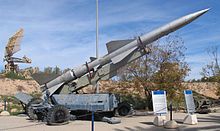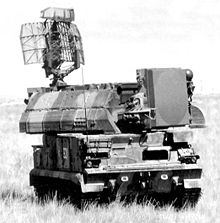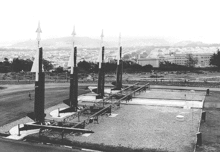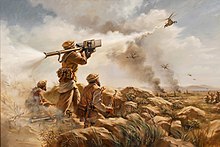Anti-aircraft missile

An air missile (short FlaRak ), and ground-to-air missile or SAM for English surface-to-air missile is a missile weapon in the fight against air targets from the ground surface (water, soil). A large number of designs and types have been developed, which differ in terms of purpose, range and technology.
Development history
German developments in World War II
The first surface-to-air missiles were developed in the German Reich from 1941 during the Second World War ; the first trial starts took place in autumn 1944. The development work for the following projects ran parallel to each other:
- The Henschel Hs 117 butterfly , a radio-controlled, two-stage rocket weighing 420 kg, tracked either optically or via radar, with a range of 16 kilometers and a summit height of 11,000 meters.
- The Messerschmitt Enzian rocket, a converted Messerschmitt Me 163 Komet weighing 1.8 tons (including 300 kg warhead), slightly higher peak height and range, and the same targeting system as the Henschel Hs 117 .
- The waterfall rocket, developed by the German Research Institute for Gliding (DFS) and the Elektromechanische Werken Karlshagen (Triebwerk), a scaled-down A4 that, with a peak height of 20,000 meters, completely overwhelmed the target system controlled by the operator on the ground.
- The fire lily , whose engines were manufactured by Rheinmetall-Borsig in Berlin-Marienfelde and whose cells were manufactured by the Ardelt-Werke in Eberswalde , in the following variants:
- Subsonic version F 25 was 1.80 meters long and had a range of five kilometers. The first trials were started in 1944 and discontinued the same year.
- Supersonic version F 55 with alcohol - liquid oxygen engine. It had a range of 10 kilometers, the first trial start in mid-1944.
- The Rhine subsidiary , developed by Rheinmetall-Borsig from 1942. Two-stage supersonic rocket.
Considerations have also been given to automatic radar tracking. All systems were ahead of their time, but came too late to be effectively used in war.
A portable, non-guided anti-aircraft missile system against low-flying aircraft was also under development towards the end of the war:
- The Fliegerfaust- A was developed in 1944 by HASAG (H. Schneider AG, Leipzig) and consisted of an approximately 1.5 meter long tube bundle with four 90 gram unguided 2 cm rockets. Each rocket carried 19 grams of explosives. The improved type Luftfaust or Fliegerfaust-B consisted of a tube bundle with nine 2-cm missiles. The rockets were fired in two volleys 0.2 seconds apart and formed a fragment cloud about 60 meters in diameter at a distance of 500 meters. The 6.5 kilogram air fist was fired from the shoulder , similar to a bazooka , and was almost recoil-free.
- A similar weapon consisted of a converted improved regular bazooka . A fragmentation charge mounted in front of the shaped charge warhead was triggered time-controlled after the start.
In March 1945 an order for 10,000 weapons with four million rounds of ammunition was started. However, only 80 of these weapons were in the troop test at the end of April 1945.
A six-barrel version with a larger caliber was still being developed, which was simply to be called Fliegerfaust (without the suffix A or B).
Cold War and the post-reunification period

After the Second World War, after the Second World War, anti-aircraft missiles became increasingly important in the West and East with the great development spurt in jet aircraft , but also in rocket engines , radar technology and electronics . Above all, the Soviet side invested great resources in the development of anti-missiles against possible American bomber attacks, since their aircraft technology was often superior to its own. In other trouble spots, too, forces allied to the Eastern Bloc were often confronted with superior air power, so that Soviet anti-aircraft missiles were used much more frequently against US aircraft than the other way around.
The Soviet S-75 played an important role in the Vietnam War from 1964 to 1975. The anti-aircraft missile reached deployment heights of 7,500 to 16,000 meters, had a radar-guided automatic guidance system and was the first time a threat to US warplanes . In the late phase of the Vietnam War, also used the shoulder-supported Strela-2 , which scored 204 hits in 589 missions between 1972 and 1975 against US fighter jets.
In the Middle East conflict , surface-to-air missiles first played a major role in the 1973 Yom Kippur War . Egyptian and Syrian S-75 and Osa positions posed a serious threat to the Israeli air force , which could only be overcome with the use of new electronic warfare systems supplied from the USA .
The Soviet (later Russian) systems were subsequently regularly developed and diversified:
- In the short-haul area via 9K33 Osa and 2K22 Tunguska to the 96K6 Panzir .
- In the middle distance range 9K37 Buk up to the current 9K330 Tor M1.
- In the long-range sector, the 2K11 pitcher introduced in 1967 was replaced from 1982 by the systems of the S-300 series, such as the S-300P and the S-300W , the first fully mobile missile defense system at the time . Further developments are S-300PM, S-400 Triumf and S-300W.
New American developments on the part of the attacking missile were reflected with some delay in new defense systems on the Soviet side: The stealth technology led to new, more powerful radar systems with phased array antennas in the S-300P and its successors, precision-guided ammunition and unpowered ammunition Guided missile for the fast-reacting and mobile Tor-M1 system .
Until recently, two main FlaRak systems were used on the western side:
- Nike Ajax and Nike Hercules were designed for use against high-flying, supersonic and multiple targets (e.g. against bomber pods); the first launch was in 1955. In addition to the conventional ones, two different sized nuclear warheads were intended for combat operations. These were also kept ready in the systems of the German Air Force ; last as an option for floor-to-floor use. Thanks to the radar steering, this system was quite accurate, but it was not designed to be mobile. Even before reunification , the Nike Hercules FlaRak system began to be decommissioned .
- HAWK is a mobile, all-weather medium-distance system that was intended for targets at a maximum distance of 40 km and an altitude of 12 km; some of it is still in use today in some NATO countries. The first HAWK units of the Bundeswehr were introduced to the Air Force in 1963 . The last HAWK system in service with anti-aircraft missile group 15 was decommissioned in the late summer of 2005 with a ceremonial tattoo.
The successor to both systems is the Patriot system . The German Air Force operates a total of 24 squadrons with this system in three squadrons.
The US Army also has a short-range anti-aircraft missile system based on the AIM-9 Sidewinder , the MIM-72 Chaparral .
Asymmetrical conflicts
In the later - increasingly asymmetrical - military conflicts, shoulder-mounted anti-aircraft missiles played an increasing role on the materially inferior side : In the Afghanistan war , American stingers and British blowpipes were successfully used against Soviet helicopters . Western forces faced similar problems in Somalia in 1993 and in the 2003 Iraq war . Iraqi fighters used Soviet 9K32 Strela-2 (SA-7) as well as more modern 9K34 Strela-3 (SA-14) and 9K310 Igla-1 (SA-16) against US helicopters - in spring 2007 there were eight in Iraq within four weeks Shot down US helicopter.
It is believed that of the fewer than 100,000 launch devices produced, some have ended up in the hands of non-governmental organizations. According to Jane's Intelligence Review in 2001, 13 of these groups were most likely to have shoulder-mounted air defense systems. Some of them are considered terrorist. In addition to al-Qaida and its sub-organizations, these include the FARC , the PKK , Hezbollah and (until the end of 2009) the Tamil organization LTTE . 14 other non-governmental groups are believed to have such systems in place. With the 2003 Iraq war and the civil wars in Libya and Syria , a number of such weapons likely fell into the hands of armed groups in North Africa and the Middle East. The United States Department of Defense also holds Iran responsible for the proliferation of such weapons systems in the region. Users of shoulder-launched anti-aircraft missiles now include, for example, groups from the Syrian insurgency movement and the Egyptian Ansar Bait al-Maqdis .
terrorism
When terrorist attacks are from 1975 to 1992 in up to 40 cases shoulder-aircraft missiles against commercial aircraft used been partially successful, were being recorded up to 760 deaths. Growing concern after the terrorist attacks on September 11, 2001 , and a failed attack in Mombasa in 2002, first led Israel to consider the use of IR decoys in commercial aircraft. The move introduced in the US Congress to make this compulsory on certain routes was not implemented in 2006 because of dubious benefits, for reasons of cost and because of objections from the airlines.
Weapons control mechanisms
Despite the threat posed by shoulder-mounted air defense systems, effective international weapons control mechanisms were late in enforcing. The USA was in the lead here, already enforcing strict end-user controls towards the end of the Afghan war . In the early 1990s, a buyback program was initiated for the Stinger air defense systems delivered to Afghanistan . It was not until the end of 2000 that the signatory states to the Wassenaar Agreement were ready to demand similar end-user certificates for their exports. Russia signed a similar agreement in 2002 with the CIS states . In 2003, APEC followed , making China the last major supplier of shoulder-based air defense systems to be involved in the relevant weapons control measures.
commitment

Anti-aircraft missiles with semi-active homing require a constant stream of data through the fire control radar . Until the 1980s, a separate radar was mostly used that exclusively pursued this task. In systems of Soviet origin, the missile positions were generally arranged in a star shape around the radar. If the radar was switched off - for example by means of disruptive measures, bombs or air-to-ground missiles - the missile positions associated with this radar were incapable of combat. Newer air defense systems such as the mobile Russian Buk M1 , on the other hand, integrate the radar on the launch vehicle. This means they can be used more flexibly and, above all, independently of central control systems.
Anti-aircraft missiles with an infrared seeker do not require radar to combat targets. This is only necessary for airspace monitoring and is often integrated in the starter vehicle (as with ADATS and 2K22 Tunguska ). Missiles with infrared guidance, however, have a shorter range and are more susceptible to interference than electronic countermeasures. It is advantageous that the opposing pilot does not receive a radar intrusion warning and the time window for countermeasures is thus reduced.
The following deployment procedures are used when deploying air defense systems:
Ambush
In the ambush tactics ( English ambush all anti-aircraft positions have) turned off their radars. The intrusion of enemy aircraft is tracked via third-party radars and other aerial surveillance procedures. As soon as the enemy targets are within range of the anti-aircraft missiles, all positions switch on their radar at the same time and fire missiles in volleys at the enemy. The advantage of this tactic is that the enemy pilots only receive a radar warning shortly before the surface-to-air missiles are fired, which means that their time frame for effective countermeasures is very short. The disadvantage is that the air defense positions have to rely on a functioning airspace surveillance, since they are blind themselves due to the switched off radar .
flash
When flashing ( English Blinking ) connect two aircraft missiles positions alternately for a short period of their radar on and off. Here are flashing on the radar warning device of the intruding aircraft alternating the warning signs, which was eponymous for this tactic. The aim is to make it more difficult for approaching SEAD aircraft to target.
External lighting
The external lighting ( English Buddy Launch ) is the Blinking very similar tactics. The difference is that not all positions alternately take over the target tracking, but one position has the target constantly in sight and supplies the other positions with the necessary information for the attack. Again, this is a tactic that serves to prevent attacks on the anti-aircraft missile positions by enemy SEAD operations.
Russian FlaRak systems and users of Russian anti-aircraft technology use the combined fire process . According to the firing rules, a predetermined number of guided missiles should be fired at a target. With Russian systems, the fire sequence is specified by the manufacturer, as is the number of LFK to be fired per target fight. Here is an example for the S-125 : Salvo with two LFK from a ramp at an interval of five seconds. The modification of these shooting rules makes it necessary to intervene on the desk of the tactical lead officer (TCO / TCA) and is an exception.
With combined fire, one deliberately ignores the rules of fire: two neighboring fire units switch to a target. The typical distance from one another is 10 to 25 kilometers. Both firing fire control officers count down loudly via the tactical line and at the same time open fire with one rocket each. When live firing on the Soviet state polygon Aschuluk ( Russian полигон Ашулук ) the combined fire of German fire units had anti-aircraft missile forces and air defense of the NVA , a typical tactical combat task .
Silent
With the silent procedure, the actual defense position remains silent until the start and, if possible, also after the start. The route guidance is done either passively (manually by sight, by infrared sensor, etc.), with an external observer or illuminator, or from the missile shortly before it hits the target. The defense and reaction time of the target is thus minimized. Remote-controlled or automated defense positions as well as spatial separation of lighting, control and starting frame have already been implemented.
passive
The sensors in the air defense position or in the guided missile manage without a transmitter to be located, for example via infrared, video (optical) or manually (by sight) from the air defense position. More recent developments use the background radiation from radio and mobile radio or civil radar systems for reconnaissance and localization of potential targets or (less often) for target control.
Control technology
The spectrum of current systems ranges from shoulder-supported systems, which are operated by one man, to missiles with a range of 400 km (S-400 Triumf), which are used in conjunction with target acquisition and tracking radar systems.
Target acquisition and tracking can be done by:
Manual steering

The target is fought in line of sight to the defensive position, the guided missile is readjusted manually or partially automatically by this; an automatically controlled flight is less common. The target acquisition is usually done optically in part with image intensification. With the Roland weapon system and some Soviet models, this option was available in addition to automatic radar steering. The first German drafts towards the end of the Second World War also used such processes.
Infrared seeker head
These rockets find their target by tracking the hot exhaust jet from the aircraft or helicopter ( thermography / thermal imaging camera ). Precondition is the exact alignment to the target before the start and enough time to activate the seeker head. Infrared guided missiles do not require any further intervention by the shooter after they have been fired. (see also: Fire-and-Forget )
As a defense measure, threatened aircraft use flares , among other things , which - when ejected at a wide angle - are intended to deflect the search heads. Newer seeker heads can distinguish their spectral pattern from that of an airplane, to which in turn new flare types are adapted. At great distances, in fog or clouds, as well as targets with a low or subdued IR signature, the hit probability drops drastically.
- Soviet / Russian models: 9K32 Strela-2 , 9K31 Strela-1 , 9K35 Strela-10 , 9K34 Strela-3 and successors.
- American systems: FIM-43 Redeye , FIM-92 Stinger and MIM-72 Chaparral (with AIM-9 Sidewinder missiles); the German ocelot system also uses Stinger missiles.
Beacon steering
In the Leitstrahllenkung ( English Beam riding ), a narrow shaped radar main lobe or a laser beam aligned as precisely as possible to the target, where the missile flies along then. With a sensor mounted on the tail, the missile can determine whether it is still on the beam and, if necessary, initiate course corrections. Radar-based beacons were mainly used in earlier air defense systems and have now been almost completely replaced by other methods.
Active homing
In active homing guidance ( english Active radar homing ) has the rocket itself an active radar system and is able to find the target itself (autonomously) to identify, track and attack.
- Examples: NASAMS , MIM-104 Patriot PAC-3, S-400 Triumf
Semi-active homing
(In the semi-active homing steering English Semi-Active radar homing , SARH ) is illuminated the target by the target tracking radar of the FlaRak system, the rocket is reflected from the aircraft by the radar waves to the finish. It steers towards the target illuminated from the ground and has no active radar and no other sensor itself (see passive radar ).
The disadvantage of this method is the high radar power required, since the receiver in the rocket is less sensitive than a ground-based antenna. The ground penetrating radar must also maintain this power until the target is destroyed, which makes the anti-aircraft missile battery sensitive to counterattacks by anti-radar missiles . Their first model was the AGM-45 Shrike , which was first available in 1963 ; its modern successor is the AGM-88 HARM , which was also used by German tornadoes in the Kosovo war against Serbia .
- Soviet types: S-200 , S-300W , 2K12 Kub , 9K37 Buk
- US types: MIM-23 HAWK
Command steering
This SAM type ( English Command-Guided Missile Radar ) requires a constant control signal by the ground station. The missile receives the control commands from the weapon system or from a separate fire control radar. The advantage over SARH is the higher accuracy, since the more complex radar and fire control technology is available on the ground. Thanks to modern phased array radar systems, it is possible to focus on the target, which makes counterattacking with HARM weapons more difficult.
- Soviet types: S-75 , S-125 Neva , 2K11 Krug , 9K33 Osa , 2K22 Tunguska , 9K330 Tor-M1
- US types: Nike Ajax and Nike Hercules
Track-via-missile
The TVM method combines the semi-active homing method with command guidance: the missile receives the signal emitted by the ground penetrating radar and reflected by the target, but forwards it back to the ground station via a radio data link. There the target tracking data is calculated and the control signals in the target radar signal are sent back to the missile. This combines two advantages: the missile is technically less complex, the ground station has higher computing power and the tactical command system. The method enables the highest level of accuracy and is used today in all modern long-range anti- aircraft missile systems and anti-missile missiles .
- Russian types: S-300P , S-400 Triumf
- US types: MIM-104 Patriot
Seaker-aided ground guidance
This method of targeting is an extension of the track-via-missile method. As with the TVM method, the ground penetrating radar illuminates the target and the sensor in the missile receives the reflected signal. However, with the SAGG method, the ground penetrating radar also receives the radar waves reflected from the target itself. In addition, the missile automatically calculates an interception course based on the received signal, but sends this to the ground station via a data link. A separate interception course for the missile is calculated in the ground station and compared with the course calculated by the missile. The more precise interception course is then transmitted to the rocket via data link so that it can then steer towards the target. Compared to the TVM method, the SAGG method is more accurate and reliable because, unlike the TVM method, both the rocket and the ground station can calculate an interception course, but it is also more complex and expensive.
- Examples: S-300P , S-400 Triumf , Bavar-373
Activation after the start

The activation after the start ( English Lock-On-After-Launch , LOAL ) combines the command control with active search heads. After launch, the rocket receives the control commands from a separate fire control radar. As soon as the guided missile is close enough to the target, it activates its own seeker head and locks the target on. From this point on, the rocket does not require any further intervention by the shooter and steers itself towards the target ( fire-and-forget ). The advantage is that the fire control radar no longer has to have direct visual contact with the target after the weapon has activated it.
- Examples: Type 81 Tan-SAM , NASAMS , New Generation guided missiles , MEADS
See also
literature
- Eberhard Birk , Heiner Möllers (Ed.): Air Force And Air Defense (= writings on the history of the German Air Force . Vol. 6). Hartmann, Miles-Verlag, Berlin 2016, ISBN 978-3-945861-48-6 .
Web links
Individual evidence
- ^ Spiegel Online, Feb. 22, 2007
- ↑ Alexandra Schmitt, MANPADS at a Glance @ armscontrol.org (from March 2013).
- ^ Small Arms Survey 2004. Rights at Risk. Ch. 3 - Big Issue, Big Problem? MANPADS
- ↑ What is blinking - is there blinking? Retrieved January 9, 2009 .



